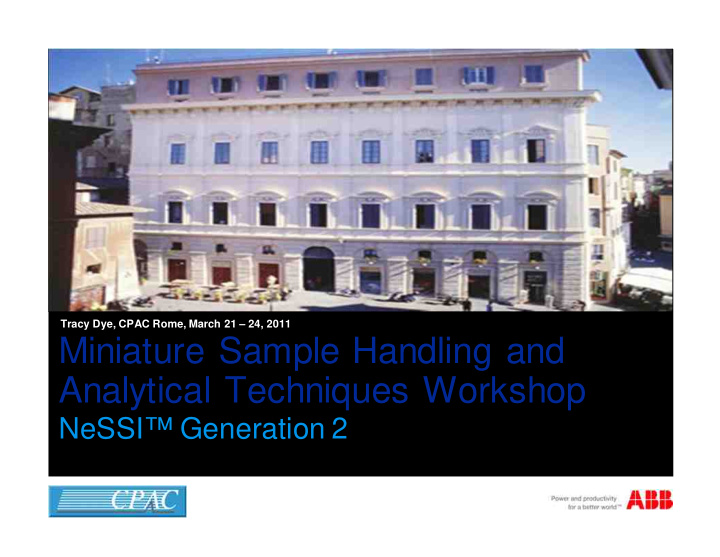



Tracy Dye, CPAC Rome, March 21 – 24, 2011 Miniature Sample Handling and Analytical Techniques Workshop NeSSI™ Generation 2
NeSSI™ Generation 2 Outline � Introduction � System Requirements � Managing Industry Perceptions � The NeSSI™ Value Proposition � Real Field Installation Examples � Takeaways
NeSSI Generation 2 Introduction � Based on the use of the miniaturized, modular analytical systems designed to the ANSI/ISA SP76.00.02- 2002 standard substrate (Gen 1) � Integration of electrical components on IS communication bus
System Requirements Communication Bus Maintenance on demand requires remote diagnostic and alarming capability. Sensing and control devices (Pressure, flow, temperature, valve actuation, ∆ P , SAM ) � A means of defining different SHS alarm states � Basic Remote Capability Means of transmitting the SHS status and alarms � Sensing/control devices are inside a heated SHS enclosure � Class 1 Division 1 Groups A,B or Zone 0,1 Group IIC hazardous ratings � Harsh corrosive environments and extended elevated temperatures � Application Small device footprint (1.5” x 1.5” or 1.5” x 3”) � Reasonable ROI including TCO, continuous focus on safety � Integration into existing plant network & analyzer infrastructure � Open communication standard that fits in the OSI network model � End User Does not compromise plant network robustness or security �
System Requirements Intrinsically Safe Method of Protection Resistive Energy Curve to Ignite Specific Gases In Presence of Oxygen and Ignition Source It’s all about the voltage!! Group A (Hydrogen) service dictates that <1A any 24VDC device must draw less than ~150mA (w/ safety factor included) Allows for 9.5V which allows up to 1000mA of current with safety factor included, 8.5W total <150mA All digital devices only require 5 or 3.3V, therefore large numbers of 9.5VDC digital sensors can be put on one power rail. 24VDC
System Requirements Sensor Actuator Manager (SAM) � A stand alone or embedded device � Communication bridge between C1D1 (Zone 1) and C1D2 (Zone 2) for CAN communications � Integrated analog I/O to digitize 4-20mA or 0-10 VDC devices � Obtains inventory of all CAN networked devices using electronic data sheets � Monitors total system “inventory” and health/status � Has a basic application interface that can pass alarm triggers and set points down to devices and pass alarms and data up to GC � Future upgrade path for CAN device metadata to provide system configuration data up to HMI at GC interface or “stand alone SAM”
System Requirements Network Topology from Sample Tap to DCS DCS Maintenance PC Analyzer LAN Embedded Embedded C1, Zone1 Stand Alone C1, Zone2
Managing Industry Perceptions NeSSI is Too Complex Discrete I/O Serial Bus/Network � Multiple single wiring � One daisy chain loop runs through IS � One signal cable to barriers DVM inside SHS � Multiple stainless enclosure valve tubing runs
Managing Industry Perceptions NeSSI is Too Expensive � Full analog system vs IS communication bus � Discrete wiring is expensive � IS barriers are expensive � Limited information less efficient use of technicians time
IS CANbus Value Proposition Cost of Ownership 64% of the time Cost study performed at chemical plant comparing digital bus to 4-20mA installation Breakdown of reasons for field visits captured in digital field bus study
IS CANbus Value Proposition Upfront capital cost for 2 stream vapor SHS $16,000 Traditional system $14,000 was instrumented with PLC and 4-20mA $12,000 $3,975 pressure and flow devices with IS $10,000 M echanical Hardware barriers Digital Bus Cabling $8,000 PLC Hardware Digital NeSSI™ Electrical Hardware system exhibited a Solenoid Valves $6,000 28% upfront cost T otal Sensors decrease due to $4,000 elimination of IS wiring, barriers, extra $2,000 fittings and tubing $0 IS CANbus Traditional
The NeSSI™ Generation 2 Value Proposition Time, Money and Safety � Maintenance on demand vs scheduled maintenance and predictive vs reactive � More efficient use of limited analyzer technician time � Remote access to critical process data � Off specification product flaring � Environmental fines � Employee safety (priceless) � Remote diagnostics and control � Valve switching and flow measurement � Flow control � Standard vs Custom designs � Less time to engineer a system (no variability in design) � Less expensive to maintain
Real Field Installation Examples NeSSI Generation 2 Components
DCS Real Field Installation Examples Maintenance ABB Ambient Air Monitoring System PC Analyzer LAN
DCS Real Field Installation Examples Maintenance Siemens Ambient Air Monitoring System PC Analyzer LAN P&F Power Supply I 2 C Barrier mounted internal
The Future NeSSI Generation 3 � NeSSI™ Generation 1 and 2 technology enablers for Generation 3 � Integration of micro/mini analytical devices with digital SHS components on ANSI/ISA SP76.00.02-2002 standard substrate At-line and wireless � � Represents an opportunity to drastically reduce the infrastructure costs associated with traditional process analytical systems
NeSSI™ Generation 2 Takeaways � The “generations” of NeSSI™ are building blocks; not design revisions � There is significant R&D synergy between the lab and process environment � Lab Gen 3 systems � Process hazloc designs � ROI must be based on the Total Cost of ownership and not just the initial investment � The NeSSI™ Generation 3 building * M oore, Geoffrey (1991), Crossing the block is a potentially disruptive Chasm, M arketing and Selling High- technology Tech Products to M ainstream Customers, Harper Business Essentials
QUESTIONS?
Recommend
More recommend